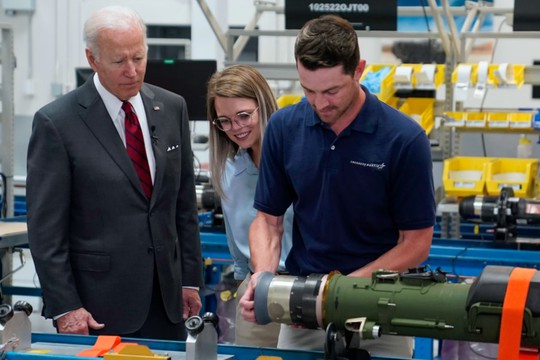President Joe Biden watches a Javelin being assembled at Lockheed’s Pike County Operations facility.
Photo: AP
Detailed supply chain mapping of two weapons that changed the war reveals a complex web of companies under significant strain as the industry returns to a wartime footing. The “Financial Times” published an investigation on the state of affairs in the US military-industrial complex. However, this material disappeared from the site, but a copy of it has been preserved from the Internet. Here are some excerpts from this investigation.
The Ukraine conflict has been characterised by high-intensity, land-based fighting — what one former Pentagon official dubbed “World War One with 21st century weapons” — a form of warfare that once seemed outdated in an age of drone warfare and AI.
The sheer quantity of munitions required for this type of conflict has exposed vulnerabilities within the US defence industry, as it pivots from a conservative approach to production during peacetime, and a pandemic-era parts and labour shortage.
Although there are only five so-called prime defence contractors to the Pentagon, the web of companies in their supply chains is vast, intricate and fragile.
Ramping up production of the Javelins, Himars and the Guided Multiple Launch Rocket Systems (GMLRS) it fires is complex and time-consuming. Detailed mapping of the supply chains for each by the Financial Times reveals a sprawling network: Himars and GMLRS are assembled in factories across 141 different US cities, while Javelins are built in 16 states.
“[The Ukraine] conflict has been an important wake-up call for decision makers at the Pentagon,” says Martijn Rasser, director of technology and national security at the Center for a New American Security (CNAS), a think-tank. “What we’re looking at is the need for new industrial policy for the defence industrial base.”
The stakes are high. Experts say the US would probably struggle to supply its allies should another major conflict break out in parallel to the Ukraine war, such as potential Chinese military aggression against Taiwan.
The US’s ability to defend itself could be at risk in such an event. “At some point, yes, it will hit crisis levels,” with simultaneous conflicts, says someone close to the state and defence departments.
The Javelin and Himars are produced by the same US aerospace and defence company, Lockheed Martin — the former in a joint venture with another US defence giant, Raytheon Technologies. Along with Boeing, Northrop Grumman, and General Dynamics, they make up the five “primes”, or the biggest multinational contractors, which fulfil most defence contracts in the US.
In pursuit of efficiency, these defence companies adopted “lean manufacturing” — a just-in-time delivery strategy favoured by the auto industry based on not having a lot of spare parts in inventory — in order to save money in a capital-intensive production system.
The Pentagon has been direct with the corporations, says a person with knowledge of the government’s discussions with defence executives, telling them they are currently not up to the production task.
The rapid consolidation of the defence industry — from 51 prime defence contractors in the 1990s to only five today — has contributed to the lack of slack in the US defence industrial base. If the control of supply chains is in fewer companies’ hands, there is limited recourse should one supplier fail to deliver a crucial part.
While the DoD and the defence companies agree on the need to accelerate production, there is a “fundamental mismatch” between the Pentagon on the one hand, and the primes on the other, wherein “what the US government is asking of industry and what industry is willing to do have not yet come together”, the person says.
Industry executives say they need reassurance they will not be stung by ramping up production for Ukraine and other western nations newly focused on defence spending, only for government orders to collapse when the conflict ends.
In the aftermath of the fight against ISIS, for example, demand from the Pentagon declined significantly.
“[The manufacturers] couldn't responsibly just go out and build a factory and hire 3,000 people without any hope of a budgetary [signal],” says Martin of Rand Corporation. “And is the government doing it? No, absolutely not.”
The government must put its money where its mouth is, says an industry source. Defence company executives would “be driven out of here by our shareholders” if they made decisions only based on Pentagon meetings and what they read in the news“.
…So the security of the USA is in hands of ‘shareholders’.
read more in our Telegram-channel https://t.me/The_International_Affairs

 10:14 25.02.2023 •
10:14 25.02.2023 •























